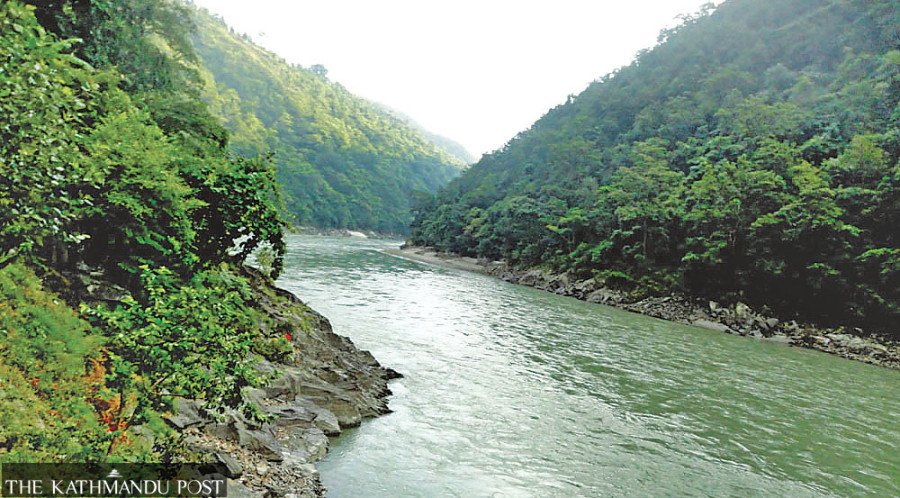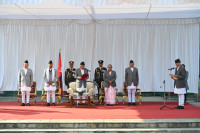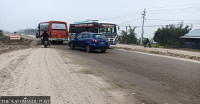National
Fate of Pancheshwar project hangs in balance with Nepal and India yet to bridge differences
Though the two sides agreed in early June to conclude the detailed project report (DPR) of the multipurpose project within three months, breakthrough continues to elude them.
Prithivi Man Shrestha
Initial momentum in finalising the detailed project report (DPR) of the Pancheshwar Multipurpose Project appears to have hit a snag with Nepal and India yet to finalise the DPR less than one month before the tenure of the team of experts ends.
The two sides had accelerated the talks on finalising the DPR of the 6,480MW project after they agreed to finalise the task within three months when Prime Minister Pushpa Kamal Dahal visited New Delhi between late May and early June.
In early July, a meeting of the governing body (board of directors) of the Pancheshwar Development Authority (PDA) was held in Pokhara. The meet extended the tenure of the expert team by six months till January 6 next year to enable the defunct body to conclude the DPR. Its term had earlier expired in March.
Then the fourth meeting of the team held in New Delhi in late July instructed India's state-owned Water and Power Consultancy Services (WAPCOS) Ltd to revise the DPR in line with the understanding reached in earlier meetings. WAPCOS took some time to submit a new draft DPR to both sides.
The fifth meeting of the joint mechanism was held in Kathmandu in early October but it also failed to finalise the DPR with both sides disagreeing on the extent of benefit from the project to each side, particularly in the areas of irrigation and flood control.
These subsequent meetings had given hope that the bilateral multipurpose project would see the light of day after remaining in limbo for nearly three decades since the Mahakali Treaty was signed in 1996. This project is an integral part of the treaty.
With the term of the Team of Experts expiring soon, the Pancheshwar Development Authority (PDA) has been pushing both sides to submit their opinions on the revised draft of the DPR in points of differences.
“We have sent letters to both the Nepali and Indian governments seeking their opinions twice in the last month,” said a source at the PDA. “One letter was sent before the Tihar last month, and a follow-up one was sent last week.”
Nabin Singh, spokesperson for the Ministry of Energy Water Resources and Irrigation, confirmed the letter’s receipt. “There has been internal discussion on the matter,” he said.
Once the PDA receives opinions from both sides, it will call the next meeting of the experts to make further efforts at concluding the DPR.
Though the two sides are narrowing down their differences on minor issues, contentions remain on key issues, particularly on who benefits what from the project.
As per a Nepali calculation, Nepal’s benefit should not be more than five percent from irrigation and flood control while the southern neighbour has proposed to keep Nepal’s benefit in the range of around 18 percent, according to an official at the energy ministry.
Quantifying the benefit for each side is important to determine the cost to be borne to develop the project based on the benefits for either side.
According to the Mahakali Treaty, the project will be designed to produce the maximum total net benefit. “All benefits accruing to both the parties with the development of the project in the forms of power, irrigation, and flood control etc shall be assessed,” Article 3 of the Mahakali Treaty says. “The cost of the project shall be borne by the parties in proportion to the benefits accruing to them. Both the parties shall jointly endeavour to mobilise the finance required for project implementation.”
While the two sides disagree on the extent of benefit in the areas of flood control and irrigation, they have agreed on keeping the benefit from hydropower equal. The two sides have more or less agreed to give the benefit from hydropower a weightage of around 70 percent while keeping the share of irrigation and flood control benefit at around 30 percent, according to the ministry official.
As per the earlier DPR prepared by the WAPCOS, the two sides will enjoy equal benefits in power but India enjoys 65 percent benefit in irrigation and 82 percent benefit in flood control.
But, Nepal, particularly, has not agreed to these recommendations because benefits to the country in the areas of irrigation and flood control could be close to nil.
According to the ministry official, Nepal could irrigate a maximum of 100,000 hectares of land following the completion of this project while India could irrigate as much as 3.5 million hectares of land.
India has a larger land mass to irrigate with the water of Mahakali, which is also known as Kali and Sharada river in India. The dam to be built for the hydroelectric project will help regulate the flow of water, minimising the flood risks for India as a downstream country.
With the two sides struggling to bridge the gap in benefits calculation, whether they would be able to conclude the DRP within the existing term of Team of Experts is doubtful, according to Nepali officials.
“If the DPR is not finalised by January 6 next year, the tenure of the expert team might have to be extended to continue the negotiations,” said the PDA source. “To achieve concrete progress, there should be more than talk for talk’s sake.”




 11.12°C Kathmandu
11.12°C Kathmandu















